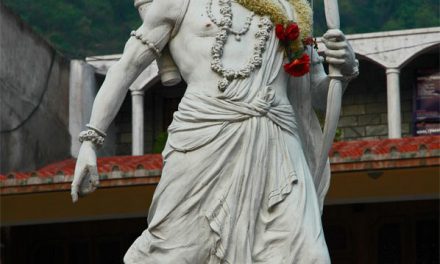 Astronomical Evidences for Rama’s Existence?
Astronomical Evidences for Rama’s Existence?
Is Ramayana a myth? If it is a myth, then what is its use? Jerry Thomas examines two arguments appeared in the Organiser, the RSS mouthpiece, which argued for the historicity of Ramayana. A close examination of those articles proves those arguments to be unfounded. After proving that Ramayana is a myth, the author explains that myth of Ramayana was an aspiration of our ancestors and a clouded pointer towards the Truth.
Archaeological Survey of India (ASI) in its affidavit on Rama Sethu Bridge said that there is no historical evidence that Sree Rama ever existed. Political parties of different colors seized this opportunity to appeal to their respective vote bank. BJP voiced against the affidavit to garner more votes, DMK spoke for the affidavit to garner more votes and Congress (I) withdrew the affidavit to garner more votes. While we leave the political parties to use, abuse, and appease religious emotions to garner more votes, it is time for religiously minded people to reason the issue to gain insights.
The question about Sree Rama’s existence brought the best and worst of Hinduism. Let us begin with the best of Hinduism. Hindus generally exhibited tolerance until now with the exceptions of a few stray incidents. There was no looting, bombing, or vandalizing in the name of a religious hurt. No matter what we disagree and disapprove of Hinduism, at least for this incident we must agree that Hindus exhibited the maturity of a civilized group. This is the best part for so far.However, there is another part that we disagree. Most of the responses dodged the question of Sree Rama’s existence as a question of faith and not of evidence. If it was so, why even protest against the ASI’s affidavit. It said explicitly nothing more than what the defenders of Sree Rama implicitly say- existence of Sree Rama is merely a matter of faith and not of any historical evidence. There seems to be no difference between the plaintiff and the defendant- a strange case indeed!!!
If the plaintiff and the defendant have agreed on the evidences, then there should not have been a dispute. But there is a heated debate. When someone points out that there is no evidence for Sree Rama’s existence, there is a debate because it makes one of the major sources of India’s culture, morality and meaning- Ramayana-an intellectually inadequate one. It makes the prayers of millions a dishonest pretension (to whom are you praying then?) and comfort of many more an invalid security. If Ramayana is a myth, then it should remain and function as a myth. We should never put our faith in a myth but only in the Truth. Myth should be read as aspirations of our ancestors and clouded pointers towards the Truth. But it should never substitute the Truth. It is worst when we substitute myth for Truth.
Before we suggest what Ramayana as myth points towards, we would like to examine the objections of a few within Hinduism who present Ramayana as a truth.
Astronomical Evidences for Rama’s Existence?
In the September 30, 2007 issue of the RSS mouthpiece, Organiser, Arabinda Ghose wrote an article titled “Sri Ram Chronology: Astronomical details left by Valmiki clinches the issue.” In this article, Arabinda quoted extensively from the book, Dating the Era of Lord Ram (Rupa and Co) written by Shri Pushkar Bhatnagar. Let me state the argument in Arabinda’s own words.
Argument: “Upon being presented with the Hindi translation of the Valmiki Ramayana (not the Tulsi Ramayana), Mr. Bhatnagar noticed that the sage had appended the names of heavenly bodies visible (or computed from deep knowledge about the movements of the planets, stars and Rashis) at the time of the birth of Ram. That generated a strong desire in Mr. Bhatnagar’s mind to verify these descriptions of planetary positions with relation to certain events, in this case the timing and date of Lord Ram.s birth.
Mr. Bhatnagar found that on the day Lord Rama was born, the sun was in Aries (Mesh Rashi), Saturn was in Libra (Tula Rashi), Jupiter was in Cancer (Karka Rashi), Venus was in Pisces (Meen Rashi), Mars was in Capricorn (Makar Rashi), it was the lunar month of Chaitra, and it was the Navami Tithi of the Shukla Paksha, the moon was near the Punarvasu Nakshatra (the star Pollux in the Gemini or the Mithun Rashi), Cancer was the lagna (it was rising at that time in the east), and Jupiter was above the horizon.
He found that in the description of the life and time of Lord Ram, there are mention of three eclipses, two solar and one lunar. While it was easy to verify the occurrence of the solar eclipse, which had taken place when Lord Ram and Lakshman had fought the demons Khar and Dushan near Panchavati, and the day the King of Kishkindha, Bali was killed, he could not initially succeed in verifying the occurrence of the lunar eclipse at the time Hanuman had met Sita, Lord Ram’s consort, at the Ashok Vatika in Lanka.
This verification took five years of Mr. Bhatnagar’s life but a lunar eclipse on November 9, 2003 had guided him to confirm the occurrence of lunar eclipse when Hanuman had met Sita.
With this, all the nine or ten parameters were successfully verified and the conclusion was that Lord Rama was born in 5114 BC, about 7000 years ago at Ayodhya. The computer was oriented towards Ayodhya by entering the latitude and longitude of Ayodhya. It was then Chaitra Shukla Navami.
Examination of the Argument: Let us exami
ne the problems of this argument.
(a) There is no peer review done to validate this finding: The methodology used by Mr. Bhatnagar is an unconventional one. His findings should have been validated by credible and scholarly astronomers.
(b) The findings actually contradict the Valmiki Ramayana itself: It must be remembered that according to Valmiki Ramayana itself, Valmiki was a contemporary of Sree Rama. One can dispute it but then he/she will be disputing the reliability of Valmiki Ramayana itself. The importance of this point is that Valmiki, by any liberal estimation, lived and wrote the Ramayana anywhere between 4th and 2nd century B.C. If it is so, how can such a big variation come between astronomical findings and scholarly dating?
(c) Linguistic evidences contradict the ‘astronomical findings’: Ramayana is written in Epic Sanskrit. The dating of Epic Sanskrit comes after the Vedic Sanskrit and before the Classical Sanskrit. If Valmiki was a contemporary of Sree Rama, linguistic evidence confirms the date between 4th Century and 2nd century B.C and contradicts the astronomical findings.
(d) Many Versions: This argument presupposes the authenticity of North Indian version of Valmiki Ramayana as against the South Indian version. Moreover, there were other versions of Ramayana which was close to Valmiki Ramayana. Romila Thapar writes in article ‘Where fusion cannot work- faith and history’: The two closest in time to the Valmiki are the Buddhist and Jaina variants. The Buddhist version in the Dasaratha Jataka differs entirely from the Valmiki. Rama is the son of the raja of Varanasi; exile is to the Himalayas; and there is no kidnapping of Sita by Ravana. The earliest of many Jaina versions, the Padmacharita of Vimalasuri, dating to the centuries AD, contradicts all earlier versions and states that it is doing so in order to present the correct version of what happened. It differs substantially from the Valmiki narrative. Ravana is not a demonic villain but a human counter-hero. It presents the story in the conceptual framework of Jainism (The Hindu, September 28, 2007). In the Jain version, Rama becomes a Jain ascetic at the end. In a similar Buddhist version (dating to anywhere between the 4th and 2nd centuries BC) Sita is the sister of Ram. When Ram was crowned king on his return to Ayodhya after his exile, Sita was made queen consort and they ruled jointly for 16,000 years, and became the originators of the royal clan. In addition, there are numerous versions of Ramayana. To read the synopsis of different versions read http://www.azibaza.com/lecture/ramayana.htm.
(e) Question of the reliability of the Text of Valmiki Ramayana: Even if we take only the Valmiki Ramayana, then also there is a question about the reliability of its manuscripts. The oldest surviving of which is dated from the eleventh century AD (Source: Wikipedia), many centuries after the original were written. Adding to the problem is the interpolation. Wikipedia notes: In the Cultural Heritage of India", Vol. IV, "The Religions", The Ramakrishna Mission, Institute of Culture, says: "The first and the last Books of the Ramayana are later additions. The bulk, consisting of Books II–VI, represents Rama as an ideal hero. In Books I and VII, however Rama is made an avatar or incarnation of Vishnu, and the epic poem is transformed into a devotional Hindu text.
(f) Valmiki Knew about the Constellation of Stars: Finally, there is nothing much in the argument except that Valmiki knew about the constellations of the stars. Homer, another classical writer like Valmiki described Homers shield in terms of constellation of stars.
{moscomment}





